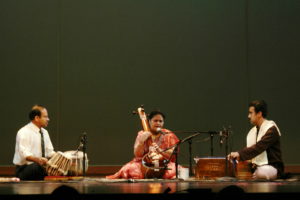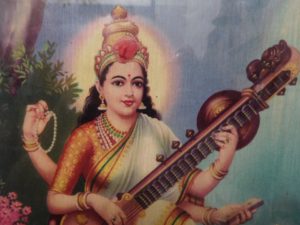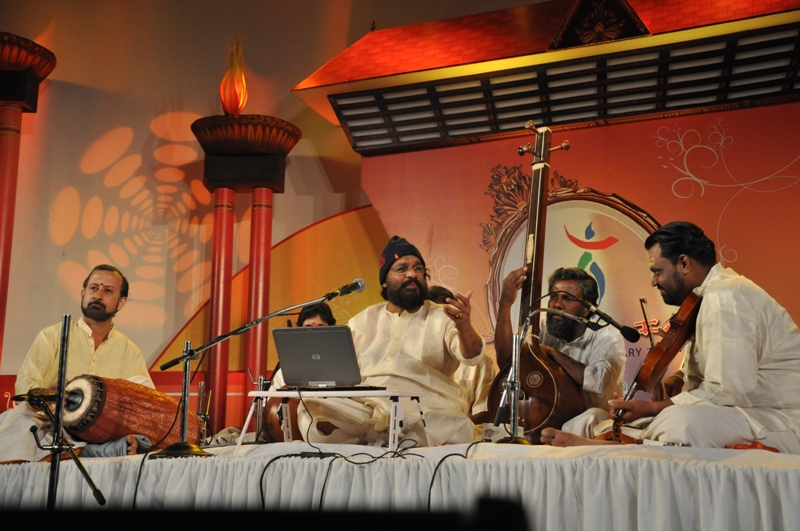Hindu music is as old as the religion itself. It originates in the Hindu beliefs and tenets and the ancient Vedic philosophy.
Hindu music can be classified as :
Indian Classical music
Devotional music
Other Musical genres
Indian Classical music :
This is a complex and complete music structure, with 12 semi-tones (or Octave as in Western Classical format) and 7 basic notes or Swaras (Sa, Re Ga, Ma, Pa, Dha, Ni, Sa alias Do, Re, Me, Fa, So, La, Ti, Do) in the pattern of Western Classical music. The philosophy underlying Indian classical music is the attainment of self-realization through meditation. It is based on Ragas and Taalas (beat rhythms).
Indian classical music is monophonic, weaved around a single melody based on a raga, and rhythmically on a Tala. Each melody or Raga is centered around various Chakras or moods, or particular times of the day, seasons or morphed as female and male Ragas. Thus Ragas are an acoustic method of adapting the self to the mood, time of day, season, etc. This is evolved as a form of meditation where the self is drawn closer to nature and her mood. Such was the esoteric power of the Ragas in the ancient times, that the composition Raag Malhaar for invocation of rain could indeed bring upon the earth an unexpected shower.
Indian Classical music is of two distinct forms
(a) HINDUSTHANI CLASSICAL MUSIC originating in North India !13th-14th centuries A.D.) and
(b) CARNATIC MUSIC originating in South India.
Both are evolved around Ragas, characterized by an ascent called Arohan and descent called Avarahon.
 While HINDUSTHANI CLASSICAL MUSIC has its origins in Vedic philosophy and Hindu traditions, it also bears influences of the Persians and Moghuls, Herein, the rendition begins with an introductory Aalap, ranging from a short (2 minutes) to long piece (30-40 minutes). It speeds up rhythmically, in the Jor, and the percussionist joins in with the introduction of Taala.
While HINDUSTHANI CLASSICAL MUSIC has its origins in Vedic philosophy and Hindu traditions, it also bears influences of the Persians and Moghuls, Herein, the rendition begins with an introductory Aalap, ranging from a short (2 minutes) to long piece (30-40 minutes). It speeds up rhythmically, in the Jor, and the percussionist joins in with the introduction of Taala.
However CARNATIC MUSIC Raaga pieces are shorter and faster in tempo. They open with a warm-up rendition called Varnam, followed by seeking of blessings, a series in the interchange between Ragams or unmetered melodies and thaalams (or jor), followed by Paalavi or the Raga theme. CARNATIC MUSIC is more theoretic and has a rigid musical structure.
Though vocal-centric, many instruments have been devised to accompany or emulate vocal performance. Musical instruments used for HINDUSTHANI CLASSICAL MUSIC are Tabla, Taanpura, Sitar, Sarod, Bansuri, Shehnai, and Sarangi.
Instruments used for CARNATIC MUSIC are Gottuvadyam, Veena, Mridangam, Kanjira, and Violin.
Devotional Music: KIRTANS and BHAJANS
KIRTANS and BHAJANS are oral renditions devoted to God. While KIRTANS are rooted in Vedic tradition, BHAJANS are more simple and of lyrical nature expressing devotion to the God or Goddess.
 KIRTAN is a form of devotional music accompanied to a stringed instrument played with a steady rhythm, It has evolved as part of the Sikh and Bengali cultures. Whereas BHAJANS are sung with great devotion, to bring the singer closer to his inner self’ or God.
KIRTAN is a form of devotional music accompanied to a stringed instrument played with a steady rhythm, It has evolved as part of the Sikh and Bengali cultures. Whereas BHAJANS are sung with great devotion, to bring the singer closer to his inner self’ or God.
The KIRTAN uses Raagas and Taalas as well. KIRTANS can be further divided as Nama Kirtans that glorify a particular deity, and Lila Kirtans that describe the transcendental pursuits of the Gods.
BHAJANS glorify God or the person held in esteem.
Other Musical Genres :
They are the TRADITIONAL FOLK MUSIC and REGIONAL MUSIC, both of which have roots in ancient India. The FOLK MUSIC again has its own set of traditional musical instruments. REGIONAL MUSIC is the different music forms of the States of India and its many regions, so they are in varied languages and dialects. These depict the local flavors of India.
The POPULAR HINDI and REGIONAL music are a modern progression, as in the Western fusions and pop music.






